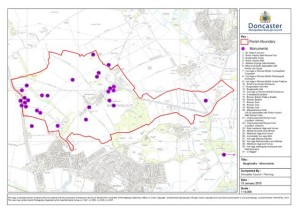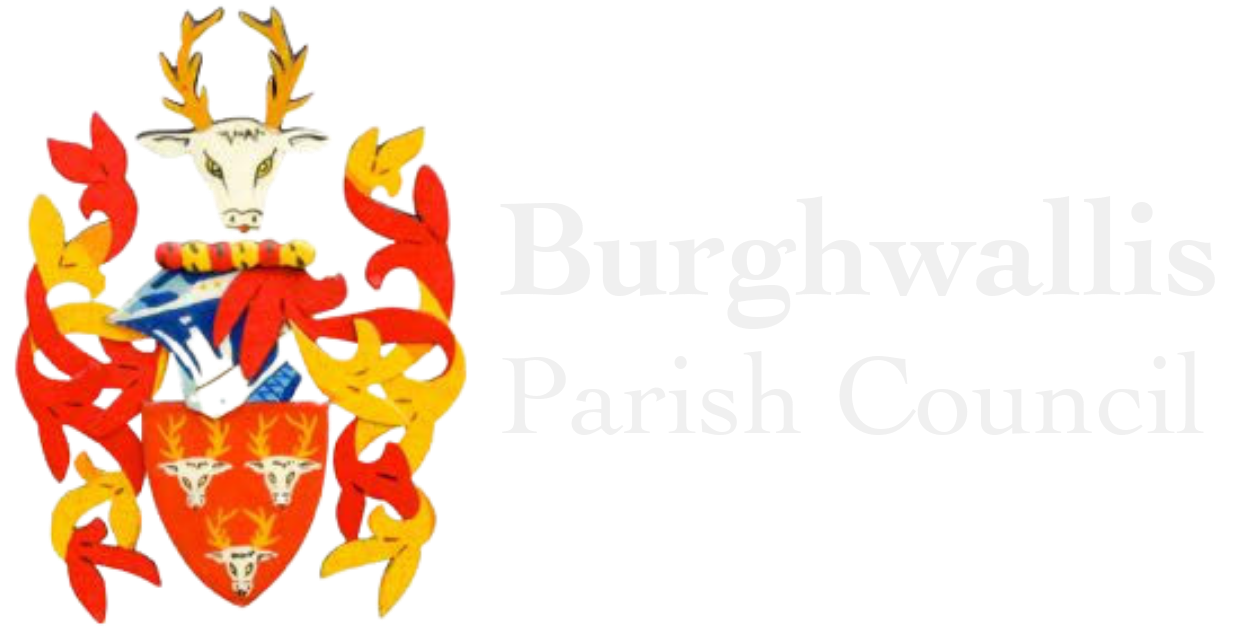Iron Age and Roman Monuments
The history books show Burghwallis to be a Saxon village originating around 1250. Whilst to most of us this seems a long time ago Burghwallis has many sites and monuments in the parish that actually stem from the Iron age and Roman occupation.
There are 31 such registered monuments spread around the parish. Regrettably they are no longer visible to we present inhabitants and only discovered from aerial photographs showing outlines and disturbances in local fields. Some were artifacts dug up around the Roman fort that lies near Robin Hood’s well just off the A1. The monuments are listed by English Heritage and can be found on the heritage gateway website. Listed below is a summary of the current findings.
The following information can be downloaded using this pdf of Burgwallis Archaeology

MONUMENT NO. 56110
Remains of late medieval churchyard cross, now incorporated into a more modern cross, of sandstone, it is believed to have also incorporated a sundial in the 18th or 19th century. Probably resited. There are no remains of a cross at the site above. A typical Medieval churchyard cross now surmounted by a modern canopied head may, however, be the original cross re-sited and restored. [shown as ”Cross” T.I. on O.S. 25” 1960 at 53691201.] See GP.AO/64/238/5. (3) SE 5369 1200. Cross in the churchyard of St Helen’s Church. The cross is located 3m south of St Helen’s Church and includes the socle and shaft of a medieval churchyard cross together with a modern cross head. The socle or socket stone comprises a dressed octagonal sandstone block with rounded stops on alternate faces. It measures roughly 80cm square and 25cm high and includes a 30cm square socket hole. The 1.5m high sandstone shaft is square with chamfered corners and includes a pedestal and capital. It is currently fitted with a modern canopied cross head but this is believed to have replaced an 18th or 19th century sundial, which , in turn, took the place of the missing medieval cross head. The existence of a sundial is indicated by the stone block placed at the foot of the cross on the north side to provide a step up to the sundial which would, otherwise, have been out of sight. The cross is Listed Grade II. Scheduled RSM no. 27205. (4)
Burghwallis Roman Fort
The site of up to three Roman forts, visible as cropmarks on air photographs. The features are all aligned north-east south-west and are incomplete with just part of the north-eastern and south-eastern sides visible. Two of the forts are double ditched and appear to differ in size. The larger a possible entrance on the north-eastern side. The smaller is on a slightly different alignment. This is more fragmentary but traces of a possible bank on the internal side of the internal ditch are visible. The third possible fort comprises a single broad ditch with possible entrances on both visible sides. No corner can be seen but it is possible that this is masked by the other features.A Roman fort with several phases of defence appears to be indicated by crop marks at Robin Hood’s Well. Roman pottery including Antonine Samian was recovered from two of the ditches visible in a disused quarry. (1) Two bronze radiate coins of Tetricus I and Carausius, and a scatter of pottery, were picked up at the fort in 1973. (2) Roman fort at Robin Hood’s Well. Two definite phases of defence can be seen from the air, both double-ditched, representing the defences of a large and smaller fort. Further cropmarks may indicate a third phase, but this requires more proof. The western portion of the fort has been destroyed by the dual carriageways of the A1, but it is striking to note that the Roman road twice realigns itself within a very short distance at this point to go through the fort. From topographic evidence it would appear that the larger fort covered about 5 acres and the smaller about 4.6 acres (over the ditches in each case). Robin Hood’s Well seems to have been known for its Roman discoveries for some time, for Hunter says the following: “It is situated on the line of the great Roman road from Lincoln to York and it is manifest from the number of Roman coins which have been discovered in its immediate vicinity, together with fibulae and other small relics of the people, that there was some kind of settlement at this spot…”. (3) Cropmarks show beyond doubt that there are two superimposed forts. (4) SE 519 120. Roman fort at Robin Hood’s Well. Scheduled no. SY/1222. (5) Up to three Roman forts are visible as cropmarks on air photographs centred at SE 5189 1200. The features are all aligned north-east south-west and are incomplete with just part of the north-eastern and south-eastern sides visible. Two of the forts are double ditched and appear to differ in size. The larger has a berm of 6m and has a possible entrance on the north-eastern side. The smaller is on a slightly different alignment and has a berm of 5m. This is more fragmentary but traces of a possible bank on the internal side of the internal ditch are visible. The third possible fort comprises a single broad ditch with possible entrances on both visible sides. No corner can be seen but it is possible that this is masked by the other features.
MONUMENT NO. 1410060
Post Medieval ridge and furrow is visible as earthworks on air photographs in the parish of Burghwallis. Some areas are no longer extant on the most recent (1990) Ordnance Survey vertical air photographs.
MONUMENT NO. 1410119
A 125m long length of double ditched trackway of uncertain date is visible as cropmarks on air photographs
MONUMENT NO. 1410190
Medieval/ Post medieval banks and ditches are visible as cropmarks on air photographs. A complex of ditches flanked by banks and banks are visible in Burghwallis Park. Their function is unclear and the features may represent more than one phase construction. A complex of ditches flanked by banks and banks are visible in Burghwallis Park. Their function is unclear and the features may represent more than one phase construction.
MONUMENT NO. 1410119
A 125m long length of double ditched trackway of uncertain date is visible as cropmarks on air photographs. A pathway, not necessarily designed as such, beaten down by the feet of travellers.
MONUMENT NO. 1025857
An Iron Age/ Roman circular enclosure, rectilinear enclosure, enclosures, trackways, field boundaries and ditches are visible as cropmarks on air photographs. A trackway running north-east south-west leads into two large conjoined enclosures or fields. Other field fragmentary field boundaries are also visible, some abuting the trackway. To the west is a broader, more sinuous trackway, again with fragments of field boundaries abutting it. A circular enclosure appears to abut the trackway and is cut by or cuts one of the field boundaries. A further three enclosures are visible. SE 546 110 (Locality only): An examination of a single air photograph (1a) reveals a trackway showing as cropmarks. Date uncertain. (1) An Iron Age/ Roman circular enclosure, rectilinear enclosure, enclosures, trackways, field boundaries and ditches are visible as cropmarks on air photographs centred at SE 5453 1069. A trackway running north-east south-west from SE5468 1114 to SE 5453 1087 leads into two large conjoined enclosures or fields enclosing an area of approximately 2.6ha. Other field fragmentary field boundaries are also visible, some abuting the trackway. To the west is a broader, more sinuous trackway, again with fragments of field boundaries abutting it. A circular enclosure lies at SE 5410 1074 and measures 15m in diaeter. This also appears to abut the trackway and is cut by or cuts one of the field boundaries. A further three enclosures are visible: A possible fragmentary enclosure lies at SE 5448 1078. A sub rectangular enclosure lies at SE 5457 1104 and measures 40m by 46m. The corner of a possible broad ditched rectilinear enclosure lies to the west at SE 5400 1080. (2-4)
MONUMENT NO. 1410287
Medieval/ post medieval ridge and furrow is visible as cropmarks and post medieval ridge and furrow is visible as earthworks and cropmarks on air photographs in the parish of Burghwallis. Nearly all appears to be no longer extant on the latest 1990 Ordnance Survey vertical photography.
MONUMENT NO. 1410195
An incomplete ditched enclosure and ditch of probable Iron Age/ Roman date are visible as cropmarks on air photographs
MONUMENT NO. 1410199
Ditches of uncertain date are visible as cropmarks on air photographs. A regular arrangement of ditches on a north-west south-east alignment are visible. It is possible that these may represent Iron Age/ Roman field boundaries and trackways but it is also possible that they may be more recent in origin. A regular arrangement of ditches on a north-west south-east alignment are visible. It is possible that these may represent Iron Age/ Roman field boundaries and trackways but it is also possible that they may be more recent in origin.
MONUMENT NO. 1410209
A probable Iron Age/Roman field boundary and ditch and ditches of uncertain date are visible as cropmarks on air photographs. The field boundary is ‘L’ shaped in form and aligned north-east south-west. A broader curving ditch lies in close proximity to it. To the south-east are other boundaries. Some of these appear to be aligned with present day boundaries and are therefore probably more recent in origin
MONUMENT NO. 1410285
Medieval ridge and furrow is visible as a cropmark on air photographs in the parish of Burghwallis
MONUMENT NO. 56107
Robin Hood’s Well – prob erected 1711 – removed & rebuilt c.1964 [SE 51721209] Robin Hood’s Well [G.T.] (1)Robin’s Hood Well, on the east side of the Doncaster road at Skelbrooke, is said to have been designed by Vanbrugh, and this is supported both by the style and the date 1711, which has been carved on the structure. (2) The well-house, correctly described above, was dismantled during road widening and re-erected at SE 51901175. See GP/AO/64/238/2 for present appearance & GP/AO/S/60/3&4 for original appearance.(3)
MONUMENT NO. 1410801
An Iron Age/ Roman rectangular enclosure and field boundaries are visible as cropmarks on air photographs. A series of fragmentary field boundaries are visible. An incomplete rectangular enclosure is incorporated into these.
MONUMENT NO. 56159
The blade of a dagger, found at Burghwallis, was donated by the Rev F W Peel to the Yorks. Phil. Soc. Mus
HER Number 03595/01
Mound of Earth associated with former ice house, Burghwallis Hall
HER Number 00454/02
The remnants of the park consists of 72 acres (29ha) of land with scattered deciduous trees. It has a general SE aspect to the run of the land. A square pond in the park could possibly be the remains of a moated site (Smith 1966) – though this is a very provisional suggestion and requires further investigation.
HER Number 0454/01
HALL HOUSE (Medieval – 1066 AD to 1539 AD) Full Description: Now St Anne’s Convent, 16th century and 17th century with 19th century alteration. From Pevsner, Addenda: “The centre part of the house is Tudor – an original Henry VII stone chimneystack is visible on the east front.” References: D.V.S, Buildings W.R. Yorkshire 1974 p.151 & 623 (Pevsner)
HER Number 00046/05
Find spot: Roman brooch associated with Robin Hood’s Well Roman Fort
HER Number 02797/01
A linear feature, probably representing a track way or lane, shows as a crop mark in fields near two enclosures [PIN 02796] and PIN 00051.
